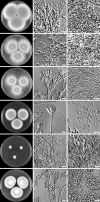Identification of Paecilomyces variotii in clinical samples and settings
- PMID: 20519470
- PMCID: PMC2916617
- DOI: 10.1128/JCM.00764-10
Identification of Paecilomyces variotii in clinical samples and settings
Abstract
Paecilomyces variotii is a commonly occurring species in air and food, but it is also associated with many types of human infections and is among the emerging causative agents of opportunistic mycoses in immunocompromised hosts. Paecilomyces can cause hyalohyphomycosis, and two species, Paecilomyces lilacinus and P. variotii, are the most frequently encountered organisms. In the present study, a set of 34 clinical isolates morphologically identified as P. variotii or P. lilacinus were formally identified by sequencing intergenic transcribed spacer regions 1 and 2 (including 5.8S rDNA) and a part of the beta-tubulin gene. Three isolates were identified as P. lilacinus, and five of the presumptive P. variotii isolates did not belong to the genus Paecilomyces but were identified as Talaromyces eburneus (anamorph, Geosmithia argillacea) or Hamigera avellanea (anamorph, Merimbla ingelheimense). Applying the most recent taxonomy, we found that the clinical P. variotii isolates could be identified as P. variotii sensu stricto (14 strains), P. formosus (11 strains), and P. dactylethromorphus (1 strain). These data indicate that P. formosus occurs in clinical samples as commonly as P. variotii. Susceptibility tests showed that the antifungal susceptibility profiles of P. variotii, P. formosus, and P. dactylethromorphus are similar and that all strains tested were susceptible to amphotericin B in vitro. P. lilanicus, T. eburneus, and H. avellanea had different susceptibility profiles; and flucytosine and voriconazole were the least active of the antifungal drugs tested against these species. Our results indicate that correct species identification is important to help guide appropriate antifungal therapy.
Figures


References
-
- Ajello, L. 1986. Hyalohyphomycosis and phaeohyphomycosis: two global disease entities of public health importance. Eur. J. Epidemiol. 2:243-251. - PubMed
-
- Arenas, R., M. Arce, H. Munoz, and J. Ruiz-Esmenjaud. 1998. Onychomycosis due to Paecilomyces variotii. Case report and review. J. Mycol. Med. 8:32-33.
-
- Athar, M. A., A. S. Sekhon, J. V. Mcgrath, and R. M. Malone. 1996. Hyalohyphomycosis caused by Paecilomyces variotii in an obstetrical patient. Eur. J. Epidemiol. 12:33-35. - PubMed
-
- Balajee, S. A., A. M. Borman, M. E. Brandt, J. Cano, M. Cuenca-Estrella, E. Dannaoui, J. Guarro, G. Haase, C. C. Kibbler, W. Meyer, K. O'Donnell, C. A. Petti, J. L. Rodriguez-Tudela, D. Sutton, A. Velegraki, and B. L. Wickes. 2009. Sequence-based identification of Aspergillus, Fusarium and the Mucorales in the clinical mycology laboratory: where are we and where should we go from here? J. Clin. Microbiol. 47:877-884. - PMC - PubMed
MeSH terms
Substances
Associated data
- Actions
- Actions
- Actions
- Actions
- Actions
- Actions
- Actions
- Actions
- Actions
- Actions
- Actions
- Actions
- Actions
- Actions
- Actions
- Actions
- Actions
- Actions
- Actions
- Actions
- Actions
- Actions
- Actions
- Actions
- Actions
- Actions
- Actions
- Actions
- Actions
- Actions
- Actions
- Actions
- Actions
- Actions
- Actions
- Actions
- Actions
- Actions
- Actions
- Actions
- Actions
- Actions
- Actions
- Actions
- Actions
- Actions
- Actions
- Actions
- Actions
- Actions
- Actions
- Actions
- Actions
- Actions
LinkOut - more resources
Full Text Sources
Other Literature Sources
Medical

